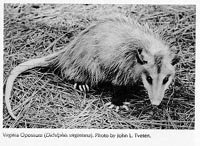Virginia Opossum (Didelphis virginiana)

TPWD ©
- Description
- Opossums are cat-sized mammals with a pointed snout, grayish fur, small ears, and a long, scaly tail. It can use its tail to hang from tree branches, and it has paws with opposable "thumbs." Males are usually larger and heavier than females.
- Life History
- The opossum is active only at night, and is a solitary animal. They have an eclectic diet and will eat both plants and animals, including rodents, young rabbits, birds, insects, crustaceans, frogs, fruits and berries, and vegetables.
Females usually have two litters a year. The babies are born after just 11-12 days, and are about the size of a honeybee. They are blind, furless, and do not look anything like adult opossums. After they are born, they crawl all by themselves into unaided into its mother's pouch and immediately begin to nurse. Soon after it begins to nurse, the nipple swells and completely fills the baby opossum's mouth, causing it to be firmly attached it to its mother. It remains attached until it is about 7 weeks old, at which time it has grown large enough to detach itself. This unusual adaptation helps make up for the short gestation period. Many opossums die during the first year of their life, and adults usually live only about two years in the wild. - Habitat
- Opossums are primarily woodland creatures, but are also frequently found in prairies, marshes, and farmlands. Although they prefer to live in hollow trees and logs, opossums will also shelter in woodpiles, rock piles, crevices in cliffs, under buildings, in attics, and in abandoned underground burrows dug by other animals.
- Distribution
- Opossums occur statewide except for the arid Trans-Pecos and Llano Estacado of the Panhandle.
- Other
- Opossums, as a group, are among the oldest, most primitive mammals of the New World. Some scientists call them "living fossils" because they have survived relatively unchanged for at least 50 million years. They are intermediate in many respects between the most primitive of all mammals, the egg-laying monotremes of Australia, and the higher placental mammals. Their chief character is the marsupium or pouch that develops on the abdomen of females. One species occurs in Texas.